
A tarantula hawk is a spider wasp (Pompilidae) that preys on tarantulas. Tarantula hawks belong to any of the many species in the genera Pepsis and Hemipepsis. They are one of the largest parasitoid wasps, using their sting to paralyze their prey before dragging it to a brood nest as living food; a single egg is laid on the prey, hatching to a larva which eats the still-living host. They are found on all continents other than Europe and Antarctica.

Wasps in the family Pompilidae are commonly called spider wasps, spider-hunting wasps, or pompilid wasps. The family is cosmopolitan, with some 5,000 species in six subfamilies. Nearly all species are solitary, and most capture and paralyze prey, though members of the subfamily Ceropalinae are kleptoparasites of other pompilids, or ectoparasitoids of living spiders.

Episyron is a genus of wasps in the family Pompilidae which prey on spiders. Nine species are found in Europe.
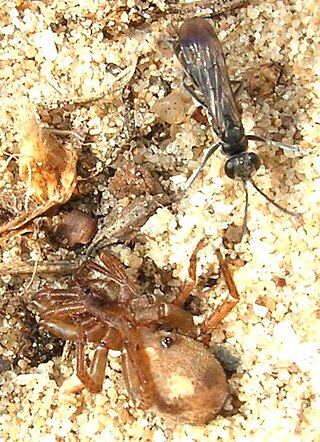
The Pompilinae are a subfamily of the spider wasp family, Pompilidae, the species of which lay their eggs on the paralysed bodies of their prey.

Pompilus is a genus of spider wasps in the family Pompilidae, the members of which prey on spiders. There are seven species recognised in Pompilus sensu stricto. It is the type genus of the family Pompilidae and the subfamily Pompilinae.

Anoplius is a genus of spider wasps in the family Pompilidae, called the blue-black spider wasps.

The Pepsinae are a subfamily of the spider wasp family, Pompilidae, including the two genera of large tarantula hawks, as well as many genera of smaller species.
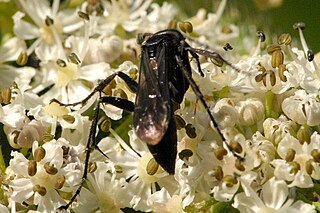
Anoplius nigerrimus is one of the most common spider wasps, or pompilids, in Europe. They are mostly black and the females are 6–8 mm long while males measure 5–8 mm. This species may be distinguished from the related Anoplius concinnus and Anoplius caviventris by the 20 setae, or hairs, on the forehead rather than 60 or 45.
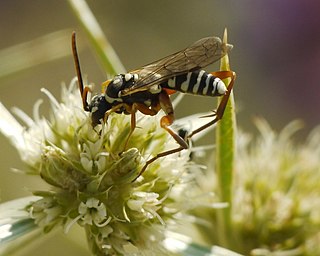
The Ceropalinae are a subfamily of the Pompilidae, the spider wasps, containing two genera, whose members are kleptoparasitic on other solitary wasps which hunt spiders, mainly fellow members of the Pompilidae.
The Ctenocerinae are a subfamily of spider wasps, Pompilidae, which contains a small number of genera, two in the Neotropics, four in Australia and the remainder in Africa. Ctenocerine wasps have evidently evolved from a common ancestor with the Pepsinae, but are specialized for preying upon trap-door spiders (Ctenizidae).
Epipompilus is a genus of spider wasps in the subfamily Pepsinae, part of the widespread family Pompilidae. Representatives of Epipompilus can be found in Australasia and North and South America. This distribution may indicate that Epipompilus evolved in Gondwana and is similar to other Gondwanan taxa such as the southern beech Nothofagus and Auracaria.

Evagetes is a genus of spider wasps from the family Pompilidae. There are 72 described species, of which 58 are found in the Palaearctic region, 11 in the Nearctic region, with a few penetrating to the Afrotropical, Oriental and Neotropic regions. Evagetes wasps are kleptoparasitic on other pompilid wasps, especially the genera Arachnospila, Anoplius, Episyron and Pompilus, digging into their sealed burrows, eating the host egg and replacing it with an egg of its own. Evagetes wasps are characterised by their very short antennae. Most are species are black with the base of the antennae rufous, several Evagetes species are very metallic bluish insects.
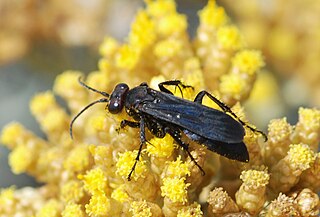
Agenioideus is a genus of spider wasps from the subfamily Pompilinae; the genus occurs in Europe, where 21 species are recorded, eastwards to Japan, in North America, South America, and Australia.

Caliadurgus is a genus of spider wasps of the subfamily Pepsinae. These are medium-sized black spider wasps with some red. They have a catholic habitat choice and their preferred prey are spiders of the families Araneidae and Tetragnathidae. They have a Holarctic and Neotropical distribution.
Ireangelus is a genus of kleptoparasitic spider wasps from the sub-family Ceropalinae of the family Pompilidae. The genus has a pan tropical distribution, being known from Oriental, Neotropical, Australian, eastern Palearctic, and Madagascan Zoogeographic regions being best represented in the Neotropics. Irenangelus is closely related to the more widespread genus Ceropales, the two genera forming a monophyletic subfamily, Ceropalinae within the Pompilidae. This is regarded as the most basal grouping of the Pompilidae but this view is problematic because of the kleptoparasitic life history of the Ceropalines, it is now considered that they Ceropalines and other pompilids evolved from a common ectoparasitoid ancestor.

Tachypompilus analis, the red-tailed spider wasp is a species of spider wasp found in most of tropical and subtropical Asia, north to Japan. These spider wasps often hunt huntsman spiders.

Pepsis grossa is a very large species of pepsine spider wasp from the southern part of North America, south to northern South America. It preys on tarantula spiders, giving rise to the name tarantula hawk for the wasps in the genus Pepsis and the related Hemipepsis. Only the females hunt, so only they are capable of delivering a sting, which is considered the second most painful of any insect sting; scoring 4.0 on the Schmidt sting pain index compared to the bullet ant's 4.0+. It is the state insect of New Mexico. The colour morphs are the xanthic orange-winged form and the melanic black winged form. In northern South America, a third form, known as "lygamorphic", has a dark base to the wings which have dark amber median patches and a pale tip.

Pepsini is a tribe of spider wasps in the family Pompilidae.
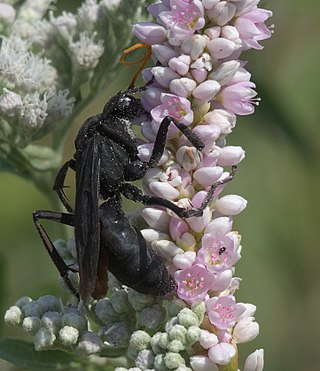
Entypus fulvicornis is a species of spider wasp belonging to the family Pompilidae. It is found in North America.

Ageniella is a genus of mud-nesting spider wasps in the family Pompilidae.















